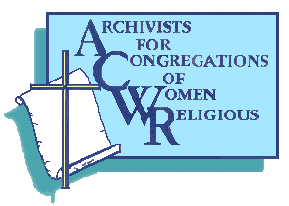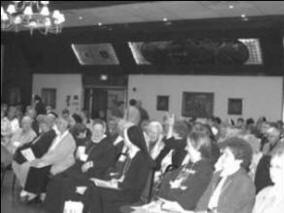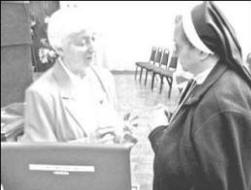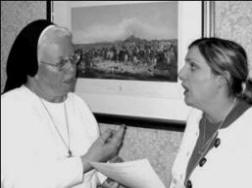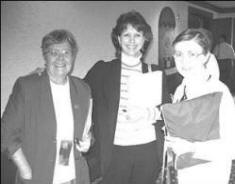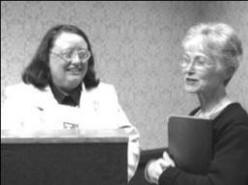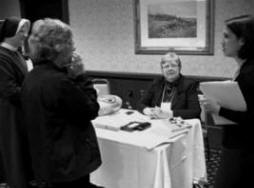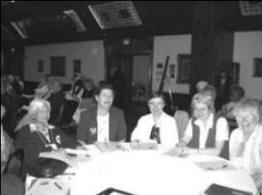|
|||||||
LETTER FROM THE PRESIDENTDear ACWR members, Whether newly appointed or long-time archivists, we were challenged, inspired, instructed; we learned new resources and skills, made new friends and were re-acquainted with other colleagues; we took the initiative and formed some regional groups and offered ideas for the ACWR web-site and the 2009 conference. Overwhelmingly, you were enthusiastic about the 2006 conference as ACWR continues its “Quest for the Best.” Your Board, new and outgoing members, appreciated your wonderful participation in discussion, both formal and informal, and your flexibility in adjusting to unforeseen circumstances! We understand that Lisa Fox is recovering and we certainly hope to have her again. And we are grateful to S. Karen Kennelly, CSJ, who was willing to up-date us on the LCWR project highlighting the history of women religious in the US, which did receive one million dollars from the Conrad Hilton Foundation. |
With 200 people in attendance and some 150 plus others who could not attend, we know there is a vast resource of members who can be tapped for their expertise. And, certainly, we know that some of you will be willing to offer your name for committees and for the election ballot for 2007- we will need a vice-president/president-elect person. As Sr. Judy reminded everyone, the Board has been/and is composed of wonderful people so our twice yearly meetings are pleasurable as well as productive! Those of you who have planned conferences know the two years at least it takes to plan such an event, so I would especially like to thank again S. Mary Jeremy Buckman, RSM, past president and S. Vickie Cravens, OSU, Secretary, for their help in the planning stages of this conference as well as earlier Board members and Elaine Stein, Executive Secretary. Let us continue to be “Stewards of the Story,” both the stories of our communities and the larger message of Jesus, and be surprised by the Spirit. Mary Denis Maher, CSA, ACWR President |
||||||
|
|
|||||||
IMPRESSIONS OF 2006 ACWR CONFERENCE THROUGH THE EYES OF NEW MEMBERSBy Mary Ann Gschwind, FSPA "Interesting,” “worthwhile,” “enriching,” “beneficial,” “eye-opening” were some of the words used by five new ACWR members to describe their first experience of our triennial conference. Sisters Mary Kay Ash, SSND (Mankato, MN), Joanne Gardner, HM (Villa Maria, PA), Lois Hoh, OP (Sinsinawa, WI) , Renee Marek, FSE (Duluth, MN) and Catherine Schiltmeyer, OSB (Norfolk, NE) all agreed that sharing experiences face-to-face with other women religious Archivists was invaluable as they begin their ministries as Archivists.
Each felt that networking
developed which will, hopefully, be ongoing. All appreciated the content of each
session they attended. And each one appreciated the willingness of experienced
Archivists to share ideas and practices with “neophytes.” All expressed
gratitude for this conference as they are looking forward already to the next
one in 2009.
|
Specific gratitude was expressed for the excellent planning, for the effective speakers and invaluable content, for the practical advice gleaned from other participants and for the worthwhile tours. What summarizes everyone’s experience was expressed this way by one person who said she “very much enjoyed being in the presence of so many wonderful religious who have the common bond of ‘honoring the past, enriching the present and protecting the future’ for our respective communities.” |
||||||
|
Plenary Session |
|||||||
|
CONFERENCE EVALUATIONS By Judith Metz, SCParticipants in the 2006 ACWR Conference, held September 28-30, 2006 at the Drawbridge Inn in Fort Mitchell, Kentucky, expressed a high degree of satisfaction with their experience. They gave excellent ratings to our three plenary speakers as well as to the panel on mergers. Presentations given at the concurrent sessions also received generally high ratings. The most disappointing aspect of the conference was the cancellations of two speakers. Many participants suggested that, since the topics of disaster planning and care of photographs are both very important, these speakers be invited to the next ACWR conference. |
A number of the evaluations contained positive comments about the opportunity the conference provided to share conversation and network with others who share the same mission/ministry. |
||||||
|
|
|||||||
|
|
There were some suggestions about how some details of the conference could have been handled differently and these will be discussed at the ACWR board meeting in November. In addition, participants offered a long list of suggestions for sessions that could be offered at the next conference. The board is grateful for all responses, especially for your feedback on what you would like our next conference to provide. Hard as it may seem to believe, the board will begin planning for that event in the near future! |
||||||
| VIEWS FROM THE 2006 CONFERENCE | |||||||
|
|
|
||||||
|
|
|
||||||
|
|
|
||||||
|
VICKIE SHARES BASIC INFORMATION FROM HER SESSION ON SOFTWARE AND HARDWARE
(Note: At the request of some attendees, S.Vickie Cravesn, OSU,
prepared this brief summary of her presentation.) He concludes that archivists don’t have to do everything. Clearly the more skills one has the better. But there are limits. Archivists should be able to articulate archival concepts using vocabulary that is familiar to technologists. Knowing the basics of how a computer organizes files and how to perform some simple operations is essential for anyone working with a computer. At a basic level, you should understand folders and how to move, copy and rename files. At a more intermediate level, you may need to understand how to perform these operations on selected sets of files, how to create lists of files, to compare the contents of files and how to map drives. The heart of archives is analyzing and organizing knowledge. Databases are the fundamental tool to do that in the digital environment. They vary from simple to more complex. It would be nice if you know something about programming. Remember most programmers know very little about our work in the archives. What may be most essential for archivists to prepare themselves for the digital era is neither skills nor knowledge, but new attitudes. We need to adopt a pioneer spirit, a willingness to face the unknown. We must be willing to take risks and experiment. The pathway of using a computer has its twists and turns. But the journey begins with a single step. The basic hardware of a computer system is: (1.) The CPU – the central processing unit. This starts the computer and makes sure it is ready to go. This will come in different sizes and shapes. (2). The monitor is the screen on which you see your work. It also comes in different sizes and shapes. (3). The keyboard where you type your information. (4). The mouse which moves you around. (5). The printer. (6). A scanner. You can scan documents and pictures into a digital image that you can work with. A camera either digital or other if you have a scanner, otherwise the digital camera pictures will download directly into your computer. (7). Internet connection. (8)Speakers, most computer systems come with them now. And (9). Backup systems, tape or zip drives. |
Software tells the computer to execute certain commands that creates what you want. The most common software components are (1). Word processing (2) Databases (3). Spreadsheets (4). Communications (5). PowerPoint and others such as OCR (Optical character Recognition). This is designed to translate images of handwritten or typewritten text (usually captured by a scanner into machine-editable texts. Purchasing computer hardware and software is an expensive situation although, now, computer hardware systems are reasonable (under $1,000). The most important thing is to get a system with a minimum of 512 k memory and several gigabytes of storage memory. I know too that there are combination printer systems that print, scan, fax and copy all in one machine. This is not a good purchase because if one part has a defect, then the whole machine goes for repair and you are without the other parts, a printer for instance. My recommendation is to buy the printer, scanner, fax machine, and photocopier individually. However, I know that money is tight in every religious community, so you abide by your particular situation. Software is the same way. It can be an expensive purchase. But with a commercial program you can get technical and some intellectual support. I am not on the payroll of the Microsoft Company, but I recommend the Microsoft Office Professional, which has component programs of word processing (Word), database management (Access), and spreadsheets (Excel). With these components, you can share information between the parts. Most community colleges offer courses in these components so you can learn how to use them. Two programs that can be used by archivists are PastPerfect Museum Software and Tabularium. PastPerfect is designed for museum use; however some archivists are trying it out. To get more information on PastPerfect, go to the website www.museumsoftware.com.
Tabularium is a program developed
by the Australian government for use in that country’s archives. It is not a
stand alone product; you need Microsoft Access to run it. Tabularium is
designed to help archivists apply sound practice in a range of archives
management activities. For further information and to get a free download copy
of Tabularium, go to the website: Time was given to S. Marcia Kimball, OSU to present the software program that she has written and developed for small archives. She can be contacted for further information at: marciak5@aol.com. The remaining few minutes were open for questions and answers and comments.
|
||||||
|
A NEW ARCHIVIST'S FIRST MAJOR ACQUISITION By Jeanne Guilfoyle, Heritage Coordinator, Wheaton Franciscans Every new archivist (including this one) wonders about receiving one’s first new acquisition, as it provides the opportunity to test much of what one has been taught in archival training. It is a live test. Will I know how to process the acquisition correctly and incorporate it into the holdings? Will I be able to make important archival decisions about what I need to keep and what is not appropriate for the collection I manage without ruining provenance? I recently had the live test! It came through the closing of St. Michael Hospital, Milwaukee, WI., I was notified that I should contact a member of St. Michael’s administration about the holdings. I did contact the vice president and was told to come, as soon as possible, to get the collection. I was informed there was “quite a bit,” but not given any specifics on what might be awaiting me! I arrived at St. Michael Hospital on May 22, 2006 and immediately sensed the transition and loss in the hospital. There were few patients and clusters of employees talking quietly and solemnly to one another. On the wall of the main corridor was a display of photographs and notes from former patients, hospital departments, and members of the community filled with memories, good wishes and messages of appreciation. The feeling of vulnerability was palpable. I reported to Administration and was taken to the hospital library, where I was shown the shelves of material I was to take. I was shocked by the volume! I had expected several boxes of things but I was not prepared for this amount! I loaded my car with as much as I could knowing it would take several more trips to get everything. I asked an assistant to drive up with me for the next shipment, each of us in our own cars, to hopefully pack up the remainder of the records. |
When I finally got it all to Wheaton and unloaded the new acquisition into the archive room, I was amazed to count twenty seven archival boxes of material and an additional twenty nine large containers of information. There were astonishing items among these documents including incredible records of the groundbreaking clinics St. Michael is known for, along with wonderful pictures of S. Jeanne Gengler and S. Illumina Gossens, former administrators, plus an entire collection of “MikeLights” news letters. What makes this collection all the more special is the fact that it was organized by S. Jeanne, administrator in the late 50s to early 60s. All the boxes are carefully labeled and the folders inside the boxes are handwritten in S. Jeanne’s own hand. Some items S. Jeanne copied from the Archives here in Wheaton to ensure the accuracy and the completion of the collection. Other pieces of documentation were photocopied from hospital records, with the original records in the hospital department’s files. Personnel from the Office of General Counsel from the Wheaton Franciscan Healthcare Inc. (WFHI) came to exam the records carefully for a full day and were most helpful. Since St. Michael continues to run a full range of outpatient services, they continue to need to be a fully licensed hospital in the state of Wisconsin. The original board meeting minutes, records pertaining to finances and loans, etc. need to be kept by either WFHI or St. Joseph’s Hospital, Milwaukee, WI., which will be carrying on the ministry of St. Michael Hospital. The records pertaining to our Sisters and their lives at St. Michael were appropriate for our archives. Other records, which are duplications of original records or outside the realm of the retention policy for hospital records, will be destroyed. This has been another huge learning for me in my life as an archivist. Always the lessons come back to a few important MUSTS, such as collaborate with others, avoid making snap decisions, and be deliberate in processing, even when the task seems overwhelming. |
||||||
|
HIDDEN TREASURES IN THE ARCHIVES By Regina Siegfried, ASC I was privileged to write the history of our community’s mission in China, a project that was published by AuthorHouse last December. Access to the papers on China meant opening files of onion-skin letters that hadn’t been touched in 50 years. That research was an encounter with a living past. Community archives hold the expressions of our future, even as they collect the voices of the past. The letters from the Adorers of the Blood of Christ in China told the story, but the narrative almost got lost through time. The story hid in the archives, talking to itself and waiting for a voice. Missionaries More and More: The History of the China Mission of the Adorers of the Blood of Christ, 1933-1945 is part of a much larger tale of communities of men and women religious and of lay Catholic and Protestant missionaries who carried their courage and faith in their hands and hearts when they sailed for unknown lands. Were the issues and challenges encountered by the Adorers similar to different from, and on a par with the experiences of other communities? How did other communities assimilate their Chinese members? How did the Chinese Sisters adapt to a community culture different from their land of origin? |
What have we learned; what can we pass on to other missionaries in future generations? What common themes evolve from our stories? These are questions that deserve to be answered. The answer to some of these questions were in the letters from China that the Sisters in the former Ruma province of the Adorers of the Blood of Christ diligently preserved and filed in the archives in the Ruma Center. In addition to letters, community annals, diaries from the imprisonment years, letters from Franciscan priests, Bishop Ambrose Pinger, OFM, and government documents were available to piece together the story of the China mission. In addition to reams of papers, the Sisters took photographs, one hundred of which were transferred to lantern-slide technology of the 1930s. These slides would have remained silent pictorial witnesses, trapped in outdated equipment if it had not been for the computer skills and diligent work of Christine Baudin, doctoral student in historical theology at St. Louis University, who laboriously cleaned, scanned, and converted each of the 100 slides into Jpg images for current computer use. Lisa Marie Dufford, another graduate student, scanned the wealth of other photos in the China collection. Texts, pictures, and context created a compelling story of one community’s mission experience. |
||||||
|
Canonical Counsel for Archives Of Particular interest to archivists is the article "Archives of Religious Communities" by Elizabeth McDonought, OP, CJD, STL, in the summer 2006 issue of Review for Religious, [65.3.2006]. S. Elizabeth notes that although there are no specific canons that related to religious communities, the section on diocesan archives [Canons 486-491] can have relevance. "Actual contents of well-kept archives truly serve to root a communitydeeply in the still-living partimony of its original charism," she remarks. S. Elizabeth plans to address the issue of sister personnel records in a future issue. You may wish to share this article with your community leadership. |
October was archives month. If you had any particular activities for your community member or others or if you joined with local groups for some activities highlighting the value of archives, please send in the information for the next newsletter. Spring ACWR Newsletter Deadline for submitting articles and pictures for the spring newsletter is March 15. Send to Mary Denis Maher, CSA, at smdm@srsofcharity.org |
||||||
|
|||||||
SPECIAL THANKSJoyce Richter, SC, Assistant Professor, Business Administration Department, College of Mount St. Joseph, has graciously and generously and ably offered to update the ACWR web-site, which many of you viewed at the conference. At your request, she has added Regina Bechtle’s presentation to the site and additional items will be considered. The website for ACWR is www.archivistsacwr.org. If you have any suggestions, please send them to Sister Judy Metz at Judith.metz@srcharitycinti.org. |
Newsletter Content Editor Sister Mary Denis Maher, CSA, PhD. * * * * * Production Editor, Elaine Stein Technology, Hal Stein (Volunteer) |
||||||
